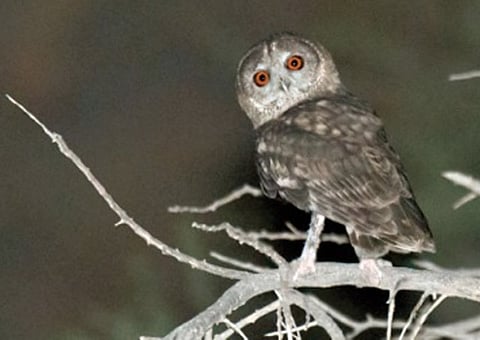New breed of owl discovered in Oman
Owl he spotted in Oman mountains could be an undiscovered breed

Muscat: A Scottish ornithologist claims that an owl he spotted in Jebel Akdhar mountains could be an undiscovered breed.
Magnus Robb, who is part of an international project called the Sound Approach that aims to catalogue and understand bird sounds, writes on the project web site that whether people agree with their proposal or not, the name ‘Strix Omanensis’ officially exists from October 4.
“Shaped like a strix owl, it [the new breed] lacked ear-tufts and appeared slightly smaller-headed than a tawny owl,” Robb wrote in his account of watching the owl and recording sounds at Jebel Akhdar.
A statement released by the Sound Approach on their website says: “The owl was first noticed in March this year when it called while researchers were making sound recordings of another species. Sound-recordist and highly commended author Magnus Robb heard a call so unlike anything he knew that the adrenaline started to rush through his veins immediately.”
“I was recording a species I know well, when I noticed some faint owl-like hooting in the background with a rhythm I had never heard before,” Robb revealed, adding that his colleague René Pop and he tried in vain to find the mystery bird again the next night. “However,” he said, “it was only on the last night of our trip that we heard it again. We had to leave for the airport with the unseen owl hooting up on a cliff.”
Robb and his team are currently writing their fifth title in The Sound Approach series aptly named ’Undiscovered Owls’. So, a month later, he was back in the mountains, this time accompanied by Sound Approach colleague Arnoud van den Berg, known for his bird photography.
“Tracking it down again wasn’t easy” said Robb. “This owl inhabits vertical terrain and its voice is difficult to hear. Worse still, in April the bird was virtually silent. Eventually we heard one. What a relief to actually glimpse it perched on a rock, confirming that this was indeed an owl and looked like nothing we had seen before.”
In May and July the Sound Approach team made two more research trips to look for new individuals, gather photographs and sound recordings, and observe behaviour. After critical analysis, they are thrilled to conclude this is indeed a new owl for science, and the first bird species to be discovered in Arabia for 77 years.
“It seems unimaginable that this owl could have led a secret existence until now, but I was in a remote location and I guess not many people have thought to go there at night,” Robb says.
“The Omani owl’s name is a tribute to Oman and its people,” he said.
“We wanted a name that fitted with the owl’s home and its heritage. We would like to think that this owl might become a focus for national pride. With only six individuals located so far, this owl needs all the protection it can get,” said Robb.
The Sound Approach team plans to continue its studies of the Omani owl in co-operation with the Omani nature conservation authorities.
Since 2000, Robb, Mark Constantine, and Arnoud van den Berg have been building a major new collection of bird sound recordings.
The collection now exceeds 50,000 recordings of more than 1,000 species, with a particular focus on the Western Palaearctic Region making this one of the largest privately owned archives of bird sound recordings in the world.
Sign up for the Daily Briefing
Get the latest news and updates straight to your inbox


